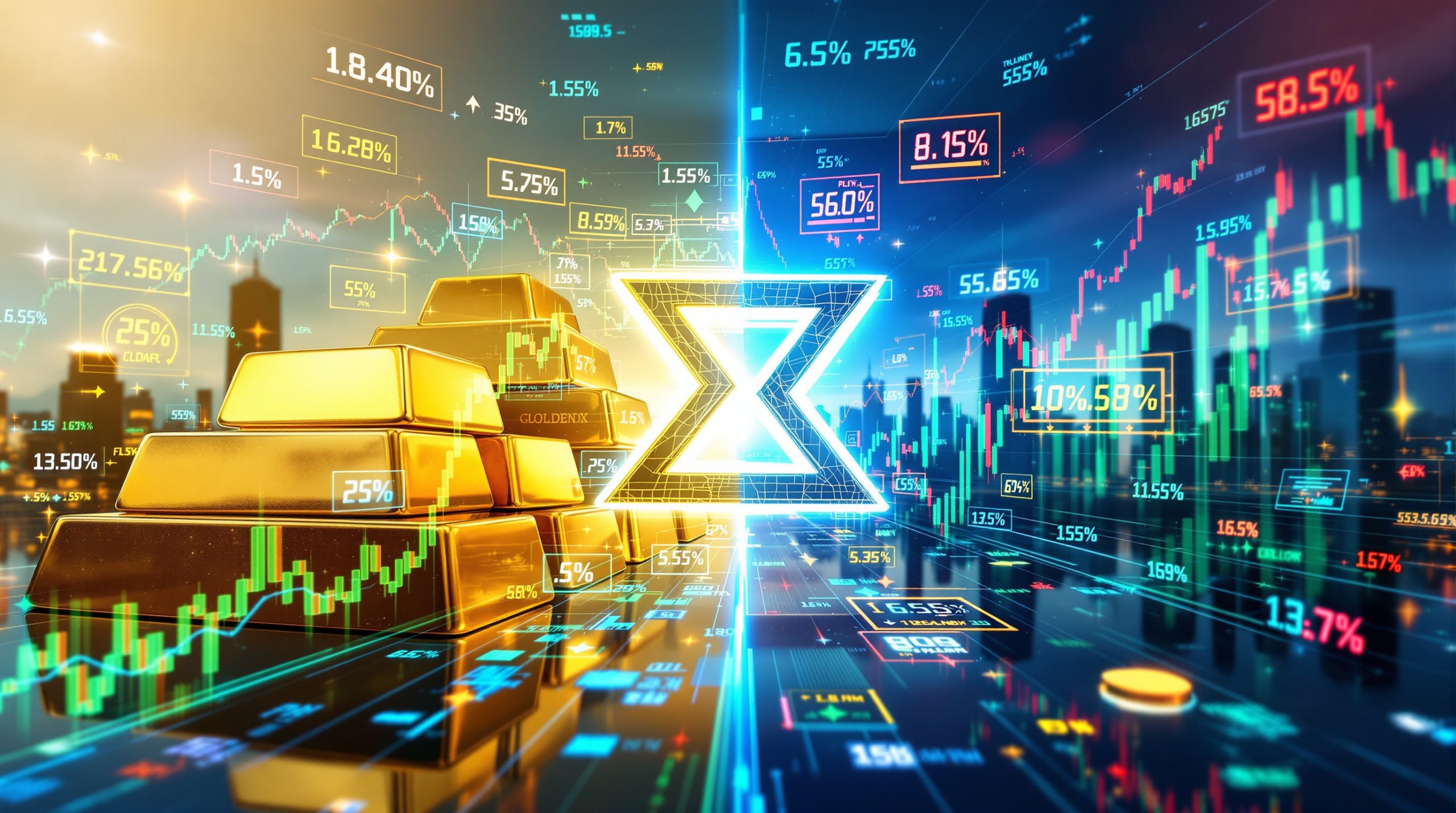What's Driving the Recent LME Zinc Price Increase?
The global zinc market is experiencing significant upward momentum, with London Metal Exchange (LME) zinc prices recording notable gains in recent trading sessions. On July 8, 2025, LME zinc closed at $2,719 per metric ton, representing a substantial increase of $36/mt (1.34%) in a single trading day. This price surge coincided with increased trading activity, with volume rising to 11,750 lots, although open interest decreased by 2,843 lots to 200,000 lots. Similarly, on the Shanghai Futures Exchange (SHFE), the zinc 2508 contract closed at 22,160 yuan/mt, gaining 110 yuan/mt (0.5%).
Current Market Performance
The recent zinc price rally reflects a complex interplay of supply constraints, macroeconomic factors, and technical market dynamics. Trading patterns show strengthening market confidence, with price movements breaking through key resistance levels despite ongoing global economic uncertainties.
The price increase follows several months of gradual recovery, suggesting fundamental support rather than speculative activity. Market analysts point to the convergence of multiple bullish factors creating a favorable environment for zinc prices to continue their upward trajectory.
Key Inventory Dynamics
Perhaps the most significant driver behind zinc's recent price strength is the persistent destocking trend observed in global markets. LME zinc inventory decreased by 2,100 metric tons to 108,500 mt on July 8, representing a 1.9% reduction in just one day. This continuing inventory decline has created tangible supply constraints in global markets, providing fundamental price support.
"LME zinc inventory continued destocking, with low inventory supporting zinc prices," noted SMM analysts in their July 9 morning meeting summary.
What makes the current market situation particularly interesting is the contrasting inventory pattern observed in Chinese domestic markets. While global LME stocks are declining, SMM-tracked inventory across seven Chinese locations rose to 89,100 mt, marking an increase of 8,500 mt from June 30. This divergence between international and China demand trends highlights the complex regional dynamics affecting the zinc market.
The sustained low global inventory levels are creating a price floor for zinc, with market participants increasingly concerned about potential supply shortages if industrial demand accelerates further.
How Are Macroeconomic Factors Influencing Zinc Prices?
Zinc prices, like those of other base metals, are highly sensitive to macroeconomic developments. Recent market movements reflect how broader economic trends and policy decisions are influencing investor sentiment and industrial demand prospects.
Global Economic Indicators
A key macroeconomic driver supporting zinc prices has been renewed expectations for US Federal Reserve interest rate cuts. After months of hawkish rhetoric, market participants are now anticipating potential monetary easing, which typically benefits commodity markets. Lower interest rates reduce the opportunity cost of holding non-yielding assets like metals, while potentially stimulating economic activity that drives industrial demand.
Additionally, statements from former President Trump regarding potential US economic tariffs have created market uncertainty. Specifically, Trump's suggestion of imposing a 50% tariff on imported copper and potentially up to 200% on pharmaceuticals has raised concerns about broader impacts on metal markets. These proposed trade measures could significantly alter global supply chains and regional price differentials for industrial metals, including zinc.
The Reserve Bank of Australia's unexpected decision to hold interest rates steady has also influenced commodity markets, adding another layer of complexity to the global economic landscape affecting metal prices.
Chinese Policy Developments
China's policy direction remains crucial for zinc market dynamics, given the country's position as both the world's largest producer and consumer of the metal. Recent statements from President Xi Jinping emphasizing the importance of building China's "energy and raw material base" signal potential support for domestic mining and refining operations.
China's expansion of Southbound Bond Connect participants to include securities firms and insurance companies represents another significant policy development. This expansion could increase investment flows into commodity-linked assets and affect metals financing.
Perhaps most important for long-term zinc demand is China's focus on developing what officials describe as a "new-type energy system." This initiative could drive substantial zinc consumption, particularly in energy storage applications where zinc-based batteries are gaining traction as alternatives to lithium-ion technology.
What's Happening in Regional Spot Markets?
Regional zinc spot markets provide valuable insights into real-world supply-demand dynamics that may precede broader price trends. Current conditions across major trading hubs reveal important nuances in market sentiment and physical metal availability.
Shanghai Market Conditions
In Shanghai, China's primary zinc trading hub, market participants report limited domestic supply, with traders maintaining high price quotes. However, downstream enterprises have been strategic in their purchasing behavior, increasing buying activity when futures prices dropped below 22,000 yuan/mt, but remaining hesitant to accept higher premiums.
Despite the supply constraints, spot premiums in Shanghai have struggled to rise significantly. This suggests a certain rigidity in demand patterns, with most end-users maintaining disciplined purchasing strategies rather than rushing to secure material. The balanced tension between limited supply and cautious demand has created a relatively stable but firm price environment in this key market.
Other Regional Markets
Regional differences in zinc market dynamics provide important context for understanding the overall market trajectory:
-
Guangdong Province: Market participants observed a slight increase in restocking activity at lower price points, with improved trading sentiment. However, spot premiums and discounts remained unchanged from the previous day, indicating a measured response to changing market conditions.
-
Tianjin Market: Downstream enterprises increased their purchasing volumes at lower prices, prompting traders to raise their quotes slightly. This led to improved transaction volumes compared to previous sessions, suggesting strengthening demand in northern China.
-
Ningbo Market: Unlike some other regions, Ningbo reported abundant zinc ingot supply, with traders actively selling despite morning futures declines. Downstream buyers purchased according to immediate needs rather than building inventory, indicating less concern about future supply constraints in this area.
These regional variations highlight the importance of local supply chains, transportation costs, and end-user concentrations in determining spot market dynamics. While the overall trend supports price strength, the uneven nature of the recovery across different regions suggests that the market rally remains vulnerable to shifts in regional demand patterns.
What's the Technical Analysis Indicating for Zinc Prices?
Technical analysis provides valuable insights into market psychology and potential price directions by examining trading patterns, chart formations, and various indicators. Current technical signals for zinc prices suggest a cautiously bullish outlook, though with notable resistance levels.
LME Zinc Technical Indicators
LME zinc formed a large bullish candlestick pattern in recent overnight trading, indicating strong buying pressure. The metal reached an intraday high of $2,740/mt before settling at $2,719/mt, demonstrating substantial upward momentum. However, the 5-day and 10-day moving averages are currently exerting pressure as resistance levels, potentially limiting immediate upside.
The technical picture is reinforced by fundamental factors, with low inventory levels providing a solid price floor. Additionally, expectations for US interest rate cuts have shifted the overall price center higher, creating a more favorable technical environment for continued price appreciation.
Market technicians note that the recent price action shows significant buying interest on dips, suggesting that the path of least resistance may be to the upside once current resistance levels are overcome.
SHFE Zinc Technical Analysis
On the Shanghai Futures Exchange, zinc recorded a long-lower-shadow bearish candlestick formation without an upper shadow. This pattern typically indicates that sellers initially pushed prices down (to an intraday low of 22,020 yuan/mt) before buyers entered the market and drove prices back up (to close at 22,160 yuan/mt).
The middle Bollinger Bands are currently providing technical support for SHFE zinc prices, preventing deeper corrections. Technical analysts have observed profit-taking by bearish traders, which has contributed to price stabilization after recent volatility.
Based on these technical indicators, market observers expect SHFE zinc to consolidate with a sideways trend in the near term, as the market digests recent gains and establishes a new base for potential future advances.
How Might Trade Policies Impact Future Zinc Prices?
Global trade policies and geopolitical developments increasingly influence metal markets, creating both risks and opportunities for zinc prices. Recent policy announcements and international tensions merit close attention from market participants.
Potential Tariff Implications
The proposed 50% tariff on imported copper could have significant spillover effects for zinc and other base metals. While zinc wasn't specifically mentioned in recent statements, trade restrictions on one base metal often impact the entire metals complex through substitution effects, supply chain disruptions, and shifted investment patterns.
Adding to market uncertainty, the US Commerce Department is reportedly planning 15-20 more tariff letters in the coming days. This suggests a broader trade policy shift that could potentially include zinc or zinc-containing products. Such measures would likely affect international zinc flows and create regional price differentials based on tariff structures.
Historical precedent suggests that tariff market impact often leads to:
- Price premiums in tariff-imposing countries
- Discounts in exporting nations facing barriers
- Shifts in production to circumvent tariff walls
- Accelerated development of domestic resources
These potential outcomes warrant careful monitoring as trade policy developments unfold.
Geopolitical Considerations
Beyond direct trade measures, broader geopolitical tensions continue to influence metals markets. The US Defense Department's announcement of additional defensive weapons for Ukraine represents another factor potentially affecting global metal supply chains, particularly given Ukraine and Russia's historical roles in European metal markets.
Ongoing US–China trade tensions will be particularly important to monitor. Recent reports indicate the US Treasury Secretary plans to meet with Chinese officials in the coming weeks to advance trade talks. The outcome of these discussions could significantly impact the outlook for zinc and other industrial metals, given China's outsized role in global metals production and consumption.
Changing international trade relationships more broadly are reshaping global zinc supply and demand patterns. Countries are increasingly prioritizing secure supply chains for critical minerals order, potentially leading to new investment patterns in zinc production and processing facilities.
What's the Forecast for Zinc Prices?
Forecasting zinc prices requires integrating fundamental supply-demand factors, technical indicators, macroeconomic developments, and policy considerations. Current market conditions suggest a cautiously optimistic outlook, though with important qualifications.
Short-Term Outlook
In the immediate term, market analysts expect zinc prices to consolidate with a sideways trend as traders digest recent gains and assess evolving market conditions. The bullish macroeconomic sentiment has prompted some bearish traders to take profits and exit positions, providing near-term price support.
Continued destocking of LME zinc inventory provides fundamental support for prices, creating a price floor that limits downside risks. With inventory at 108,500 metric tons and continuing to decline, physical market tightness could intensify if industrial demand accelerates.
Technical indicators suggest potential for further upward movement once current resistance levels are overcome. The formation of bullish candlestick patterns on LME zinc charts, combined with support from middle Bollinger Bands for SHFE zinc, creates a technically constructive picture despite some near-term resistance.
Factors to Monitor
Several key factors will determine zinc's price trajectory in coming weeks:
-
Inventory Dynamics: Any reversal in the LME destocking trend or acceleration of domestic Chinese inventory builds could signal weakening fundamental support.
-
Federal Reserve Policy: Confirmation or disappointment of interest rate cut expectations will significantly influence investor sentiment toward industrial metals.
-
Trade Policy Implementation: The actual implementation of proposed tariffs and the specific metals affected will create regional price disparities and supply chain adjustments.
-
Chinese Industrial Demand: Any policy-driven acceleration in Chinese infrastructure spending or "new-type energy system" development could substantially increase zinc consumption.
-
Technical Levels: Key resistance at the 5-day and 10-day moving averages for LME zinc, and support at middle Bollinger Bands for SHFE zinc will provide important signals for price direction.
Disclaimer: Price forecasts involve inherent uncertainties and are subject to rapid changes based on unforeseen developments in global markets, policy decisions, and economic conditions. Investors and industry participants should conduct their own research and risk assessment before making decisions based on market projections.
FAQ About Zinc Market Trends
What is causing the current zinc inventory reduction?
The ongoing reduction in LME zinc inventory is primarily driven by strong industrial demand combined with supply constraints from major producing regions. This persistent destocking trend has reduced LME inventory to 108,500 metric tons, creating fundamental support for zinc prices. Some analysts attribute the inventory decline to improving manufacturing activity in Europe and North America, combined with production disruptions at several major zinc mines. The contrast with rising Chinese domestic inventory (up 8,500 mt to 89,100 mt) suggests regional divergences in supply-demand dynamics.
How might US interest rate policies affect zinc prices?
Federal Reserve interest rate decisions significantly impact commodity markets including zinc. Current expectations for potential rate cuts are creating a bullish sentiment for metals, as lower interest rates typically reduce the opportunity cost of holding non-yielding assets like commodities. Rate cuts generally weaken the US dollar, making dollar-denominated commodities like zinc more affordable for buyers using other currencies. Additionally, monetary easing typically stimulates economic activity, potentially increasing industrial demand for zinc in construction, automotive manufacturing, and infrastructure development.
What's the relationship between Chinese and global zinc markets?
China represents both the world's largest zinc producer and consumer, making its market dynamics crucial for global price trends. The current divergence between rising domestic Chinese inventory (up 8,500 mt) and falling LME inventory (down 2,100 mt) highlights the complex interplay between these markets. Chinese policy initiatives, particularly infrastructure spending and renewable energy development, create significant demand pull that influences global zinc flows. Additionally, Chinese export policies and production costs often establish price floors for international markets, while arbitrage opportunities between SHFE and LME prices drive physical metal movements between regions.
How do technical indicators influence zinc price movements?
Technical indicators like candlestick patterns, moving averages, and Bollinger Bands help traders identify potential price directions. The recent large bullish candlestick in LME zinc, coupled with support from middle Bollinger Bands for SHFE zinc, suggests potential for continued price strength despite resistance from moving averages. These technical signals often create self-fulfilling price movements as traders act on the same indicators. In zinc markets specifically, technical analysis helps identify key support and resistance levels that frequently coincide with significant inventory or production cost thresholds. When technical signals align with fundamental factors, as in the current market where bullish technical patterns coincide with declining inventories, the resulting price moves tend to be more sustainable.
Further Exploration
Readers interested in deeper understanding of zinc market dynamics should consider exploring these related topics:
- The relationship between zinc and other base metals, particularly how copper tariffs might affect substitution patterns
- Historical correlations between LME inventory levels and price movements
- The emerging role of zinc in energy storage technologies and green infrastructure
- Regional production costs and their influence on global price floors
- The impact of changing automotive manufacturing trends on galvanized steel demand
For detailed market reports and analysis, resources such as SMM Information & Technology Co., Ltd. provide regular updates on zinc market conditions, inventory levels, and zinc price volatility trends.
Want to Spot the Next Major Mineral Discovery?
Discover investment opportunities before the market with Discovery Alert's proprietary Discovery IQ model, delivering real-time notifications when significant ASX mineral discoveries are announced. Explore historic returns from major discoveries and position yourself for success by visiting the dedicated discoveries page today.




